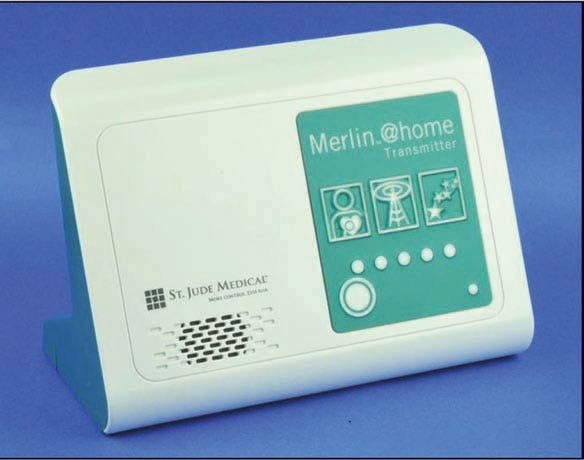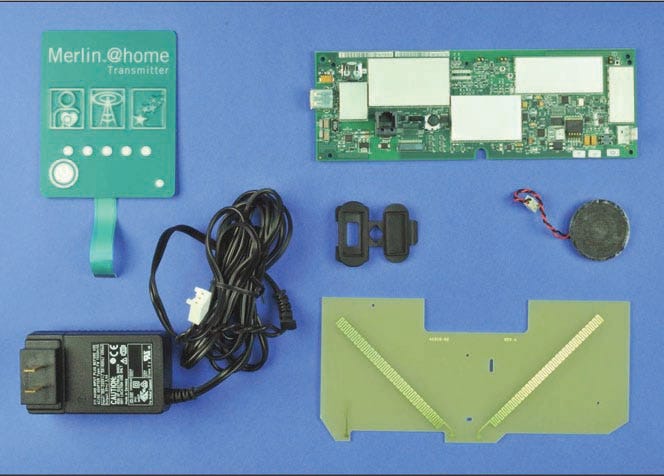March 7, 2013
As the world population continues to age and the incidence of chronic illness continues to increase, the need for monitoring the elderly and infirm grows as well. An increased focus on the monitoring of people prior to becoming ill, with an emphasis on improving behaviors that will lead to better health, also exists. Finally, monitoring of patients after release from treatment has financial incentives to ensure that treatment has been effective. These trends have led to an increase in the number of products designed to monitor various physiological conditions. In some instances, these products measure physiological parameters directly, while in others they communicate with another medical device.
The St. Jude Medical Merlin@home EX1150 transmitter is an example of the latter. A heart monitoring system designed for home use, the unit works with the company's implanted cardiac devices. To use the device, a patient plugs in the transmitter near the bed and the RF transmitter automatically monitors the device as the patient sleeps. The EX1150 uses the Medical Implant Communication System (MICS) frequency band of 402 MHz to 405 MHz to interface with the patient device, enabling efficient remote management of patients with implanted cardiac devices, including pacemakers, implantable cardioverter defibrillators, and cardiac resynchronization therapy devices.This connectivity enables the physician to provide efficient patient care management through remote daily monitoring. Once the device data are read, the transmitter automatically transmits the information to the secure St. Jude Medical Patient Care Network Web site (merlin.net), where it can be viewed by the clinician. The EX1150 communicates with the remote-monitoring center via a telephone landline, cellular adapter, or broadband WiFi service.
|
Figure 1: Disassembled St. Jude Medical Merlin@home EX1150 transmitter. Image: UBM TechInsights. |
UBM TechInsights performed a teardown of this product to provide insight into the workings of the device and to identify technology trends and innovations by examining the components and relevant suppliers. Figure 1 shows the Merlin@home device patient interface, displaying the simplicity of its icon-driven display and front speaker. Regular monitoring is required for patients with implanted cardiac devices. Historically, this has been done via scheduled clinic appointments, but advances in technology are enabling new methods for connecting with patients. Wireless pacemakers that are synchronized with remote patient systems enable daily data transmissions that can send alerts to clinicians according to settings they have defined in advance.
|
Figure 2: Disassembled St. Jude Medical Merlin@home EX1150 transmitter. Image: UBM TechInsights. |
Figure 2 shows the disassembled Merlin@home unit. The teardown reveals that the device relies on conventional off-the-shelf components, with the main processor being the Freescale MC9328MX21. This processor is targeted for advanced information appliances, smartphones, Web browsers, digital MP3 audio players, handheld computers, and messaging applications. Communications between the transmitter and the implanted device are provided by the Zarlink ZL70101, a high-performance half duplex RF communications link for medical implantable applications. Interestingly, this part is not currently recommended for new designs because it has been supplanted by a newer product.
UBM TechInsights expects to see an increase in devices designed to communicate patient conditions to remote locations for assessment. The St. Jude Medical Merlin@home transmitter is a very specific example of such a device. More information on this device--including a more detailed listing of major components and cost estimates for select components--is available with other medical device teardown reports at www.ubmtechinsights.com/medical.
William Betten is Medical Technology Director at UBM TechInsights (www.ubmtechinsights.com), which provides sophisticated information services, consulting, and management software to technology companies seeking to leverage and protect their technology and intellectual property assets.
About the Author(s)
You May Also Like




